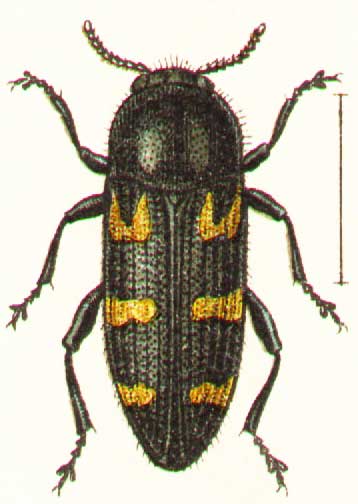
Ptosima undecimmaculata
Superregnum: Eukaryota
Cladus: Unikonta
Cladus: Opisthokonta
Cladus: Holozoa
Regnum: Animalia
Subregnum: Eumetazoa
Cladus: Bilateria
Cladus: Nephrozoa
Cladus: Protostomia
Cladus: Ecdysozoa
Cladus: Panarthropoda
Phylum: Arthropoda
Subphylum: Hexapoda
Classis: Insecta
Cladus: Dicondylia
Subclassis: Pterygota
Cladus: Metapterygota
Infraclassis: Neoptera
Cladus: Eumetabola
Cladus: Endopterygota
Superordo: Coleopterida
Ordo: Coleoptera
Subordo: Polyphaga
Infraordo: Elateriformia
Superfamilia: Buprestoidea
Familia: Buprestidae
Subfamilia: Polycestinae
Tribus: Ptosimini
Genus: Ptosima
Species: P. undecimmaculata
Subspecies: P. u. metallescens – P. u. undecimmaculata
Name
Ptosima undecimmaculata (Herbst, 1784)
References
Links
Holotype: Zoological Institute of Russian Academy of Sciences: Ptosima undecimmaculata (Herbst, 1784) - photos by M.G. Volkovich
Genus Ptosima. coleopsoc.org
Ptosima undecimmaculata, the Splendour beetle, is a species of beetles in the family Buprestidae.[1][2]
Subspecies and varietas
Ptosima undecimmaculata undecimmaculata Herbst, 1784
Ptosima undecimmaculata metallescens Bílý, 1982
Ptosima undecimmaculata var. sexmaculata Herbst[3]
Description
Ptosima undecimmaculata can reach a length of about 9–14 millimetres (0.35–0.55 in).[4] The body is cylindrical and the head is much broader than long and narrower than the pronotum.
The Latin species name undecimmaculata indicates that the species should have eleven spots (lat. Undecimo = eleven, lat. Maculatus = stained). Normally the number of spots is different than eleven. This is due to the variety of spots in number, arrangement and form.
Pronotum is black, with longitudinal stripes of rugosity. Elytra are black with three pairs of lateral, yellowish-orange or reddish transverse markings, frequently with preapical maculae. Frons and pronotal disc occasionally may have maculae.[5]
Biology
Larvae develop for 2–3 years in wood of dead trees and bushes and in living branches of Prunus. Adults emerge in May–June.[6]
Distribution
This widespread species is present in most of Europe, in the Near East and in North Africa.[7]
Bibliography
Carl Gustav Calwer und Gustav Jäger (Herausgeber): C. G. Calwer's Käferbuch. K. Thienemanns, Stuttgart 1876, 3. Auflage
H. Freude, K. W. Harde, G. A. Lohse: Die Käfer Mitteleuropas, Bd. 6. Spektrum Akademischer Verlag in Elsevier, München 1966, ISBN 3-827-40683-8
H.Mühle, P.Brandl, M. Niehuis: Catalogus Faunae Graeciae; Coleoptera: Buprestidae Printed in Germany by Georg Rößle Augsburg 2000
S. Bily, O.Brodsky "Taxonomical, biological and faunistical notes on Buprestidae and Cleridae from East Mediterrannean" Türk.Bit.Kor.Derg (1982) 6: 185-194
References
Encyclopedia of life
Biolib
P. undecimmaculata var. sexmaculata on Biolib
Beetles and Coleopterologists
Mark G. Volkovitsh, Vladimir Sakalian, Georgi Georgiev A Checklist and a Key to the Taxa of the Subfamily Polycestinae Lacordaire, 1857 (Coleoptera: Buprestidae) in Bulgaria
Forest pest
Fauna europaea
Retrieved from "http://en.wikipedia.org/"
All text is available under the terms of the GNU Free Documentation License

